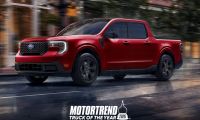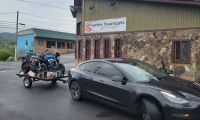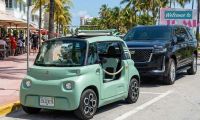For decades Europe, and especially Germany have dominated the performance/luxury market for sedans and coupes. At the same time that America created the now famous Muscle cars and Pony cars by taking the biggest, most powerful V8 engines and stuffing them into affordable midsized sedans and coupes, Europe took the same big engine recipe and added fine, luxurious interiors with top notch fit and finish and charged top dollar for the privilege of having a big luxury sedan that could accelerate, brake, and handle better than anything else in their class.
Over the years these luxurious performance sedans like the BMW M5 and Mercedes E55/63 became faster and even more capable, even as new competition like the Cadillac CTS-V and Nissan GT-R started blurring the lines between performance/luxury coupes and 2-seat high performance cars.
Now there is a new kid in town.
In 2008 Tesla came out with their fully electric Roadster which offered good handling and performance car acceleration, redefining what the capabilities and limitations of electric cars were. But at a cost over $100K they were never considered a threat to any of the performance car automakers. More like a novelty or a fad.
Tesla Models S arrives.
In 2012 Tesla came out with their Model S, a near luxury, 4-door that started at $57,400, which dropped under $50K when the $7,500 federal tax credit was applied. The base model had a 40KWh battery that was software upgradable. The top end performance Model S had an 85KWh battery which managed 265 miles of EV range, and importantly a 0-60 time of 3.9 seconds, and ¼ mile time of 12.4, which put it nose to nose with the acceleration capabilities of those impressive German performance/luxury sedans and coupes, at about the same price or less.
Tesla who?
But Tesla had no real track record in mass producing cars, and despite the Tesla Roadster, EVs were still seen as experimental, and mostly were viewed by the general public as impractical, slow economy cars. Still, the best way to convince people that EVs were as good (or better) than conventional cars was to get behind the wheel, and once journalists started driving the Model S many were blown away with the car’s amazing torque, acceleration, and near silent operation. Praise soon followed. In 2013 Motor Trend judges unanimously voted the Model S as their Car of the Year. Saying "The mere fact the Tesla Model S exists at all is a testament to innovation and entrepreneurship, the very qualities that once made the American automobile industry the largest, richest, and most powerful in the world," "America can still make things. Great things.” The Model S sold relatively well, which took a bite out of the small, but very profitable performance/luxury market that Europe had owned for so long.
Porsche’s response
Back in 2003 Porsche built their supercar flagship, the Carrera GT (which was an EV hybrid) with amazing performance results. But for Porsche’s normal car line up it took until 2012 for them to come out with the Panamera S Hybrid, which managed a 0-60 time of 5.2 seconds. The $96K Panamera S was a parallel hybrid, meaning that it could drive purely on electricity up to 43MPH, and then kick in the powerful V8. So the performance was similar to the regular V8 Panamera, but it averaged 25MPG, which was more economical than the slower V6 Panamera.
Tesla was a moving target
Tesla steadily improved the Model S, and in 2015 they released the P85D, which added a second electric engine up front which provided AWD and combined the two motors produced a whopping 691 hp and 687 lb-ft of torque. The P85D dropped the 0-60 time to an amazing 3.1 seconds, with an 11.6 sec ¼ mile time, which was even quicker that Porsche’s Panamera Turbo S. As well as nearly all of the other European high performance/luxury cars out there.
Acceleration celebrity
You could order your P85D with Insane Mode, and soon there were videos filling the internet with unsuspecting passengers being shocked and pushed back in their seats with the roller coaster like acceleration of the Model S rocket. Some Model S owners took their cars to the drag strip and we saw videos of the factory-stock Model S effortlessly blowing away hot-rodded drag racers and other high performance cars, one after another. The new idea of a performance EV quickly spread across the globe.
Mission E concept
In late 2015 Porsche unveiled the Mission E at the Frankfurt International Motor Show. Porsche said that the concept had the first 800-volt drive system, would produce more than 600 horsepower (440 kilowatts) and provide about a 310-mile battery range. Other concept-era stats include all-wheel drive and all-wheel steering, the ability to go from zero to 100 km/h (62 miles per hour) in less than 3.5 seconds, with a charging time of around 15 minutes to reach an 80% charge of electrical energy. They estimated that the entry model would cost under $85K. Later the Mission E was formally named the Taycan (pronounced Tie-Con).
Watch Porsche Mission E concept hologram and click to subscribe to Torque News Youtube channel for daily Porsche and automotive news analysis.
Tesla got even quicker
The Model S soon came out with the P90D, and P100D with bigger batteries and improved electronics that brought a quicker Ludicrous/+ mode that accelerated from 0-60 (with a 1 sec roll out) of 2.28 seconds, (10.5 sec ¼ mile) making it the quickest accelerating production car that Motor Trend has tested to date. These technical advances allowed Tesla’s Model S to out-accelerate several million dollar supercars! At least up to 100MPH.
Model 3 Performance
It was always Tesla’s goal to come out with a more affordable EV, and in 2017 they released the smaller Model 3 which introduced new battery and motor technology for almost half the price of the Model S. In 2016 Tesla got over 400,000 ($1,000) deposits in advance from people who wanted to buy the Model 3. The dual motor performance model subsequently offered 0-60 in 3.2 sec and the ¼ mile in 11.7 starting at an amazing $56K price before EV credits. Even the $48K Long Range Model 3 manages 0-60 in 4.4 sec along with 310 miles of range (with normal driving).
Back to Porsche
At the 2018 Geneva Auto show Porsche opened up deposits for the Porsche Taycan and in a month they received 20,000 (now 30,000+) reservations with a €2,500 ($2,785) deposit. Leading up to the September 4th, 2019 reveal of the production Taycan Porsche promotes the car with some demonstrations of it’s ability to take racing abuse easily. Videos of the Taycan repeatedly running from 0-100km/h (0-124MPH) https://www.youtube.com/watch?v=TP9kokeyxGU
And running 0-90MPH-0 in 10.17 seconds on the deck of the USS Hornet. https://youtube/PAX74HkmvHU , and Porsche set a new Nürburgring Nordschleife track record for four-door electric vehicles running the 12.8-mile course in 7 minutes and 42 seconds. https://www.youtube.com/watch?v=-vL637IMMX4 These were all to demonstrate that the Taycan could excel like any other high performance Porsche, and specifically target the Model S, which could accelerate quickly, but overheated under extended racing abuse in early tests.
Market heating up
Tesla had fixed this heat issue with their Model 3, which now even has a dedicated track mode, but it is unknown how the latest Model S would run at the Ring. Interestingly, Elon Musk just sent one of their new “Raven” Model S cars out to the Nürburgring this week to run in the “industrial pool sessions” where automakers and suppliers run the track in a test and tune capacity. Lap timing is forbidden during these sessions and there is often heavy traffic on the track. So the wouldn’t be able to break the Taycan’s track record even if the weather was good. But it could showcase that Tesla has now resolved the earlier heat issues with the Model S under hard track use.
Production Taycan revealed
On September 4th Porsche officially revealed the production Taycan to the world, showing the details and specs on the first all-electric-Porsche. They showed two models being introduced. The entry model is the Taycan Turbo with a MSRP of $150,900, 0-60 in 3 seconds, ¼ mile in 11.1 secs, and 279 miles max range (in the European testing). Their top model is the Taycan Turbo S. Starting at $185,000 is listed at going from 0-60 in 2.6 seconds, and 10.8 in the ¼ mile. The European test EV range is listed at 256 miles max.
Here are the comparative specs:
What’s in a name
I am bugged that they named the Taycan the Turbo and Turbo S because neither has an internal combustion engine nor a turbocharger. But Porsche marketing decided on the naming so that their customers understood that these were high performance Porsche models. So in the end marketing won out over engineering. A tiny, sad defeat.
Taycan Styling
This was another slight disappointment for me because the Mission E concept was amazingly beautiful. I think that the Taycan looks very much like a Panamera with a Mission E styled nose and tail grafted on. It is still a good looking car, just not the dazzling eye candy of the gorgeous concept.
Fast charging capability
The Taycan has an 800 volt system which allows it to charge from 5% to 80% in 22.5 minutes with a maximum charging power of up to 270 kw. This potentially means that you can add 62 miles of EV range in just five minutes. The capacity of the 800V battery is 93.4 kWh. For the first Three years the Taycan is offering free fast charging at Electrify America charging stations across the country.
Two speed transmission
In a first for EVs, the Taycan comes with a 2-speed transmission. All other EVs have single speed transmissions. Depending on the driving mode selected, the gearbox shifts from low to high under full throttle from around 50 to 65 mph. It immediately shifts to high gear when the driver eases up on the accelerator. Range mode skips low gear entirely.
Taycan’s new but familiar interior
One of Porsche’s strengths has been the quality of their interior and clean design, and the Taycan does not disappoint. All of the main instrumentation and controls are now on electronic screens. The main instrument cluster is on a curved screen in front of the steering wheel which looks like a better approach than Tesla’s large center panel. All of the gauges are shown, and being electronic, it is partially customizable with different gauge layouts. There are additional screens across the dashboard to control automotive, and media functions. And another console screen has climate control and additional features. The passenger screen is optional and can be turned off to not distract the driver. Just below and to the right of the steering wheel is a small control wheel that toggles between driving modes of Range, Normal, Sport, Sport Plus, and Individual.
How does it compare to Tesla’s offerings?
To me the biggest disappointment of the Taycan is the price. 4 years ago when the Mission E was first announced they claimed that it would be priced under $85K. With the combination of the concept’s styling, advanced design and performance, plus being built by Porsche. I thought that it was an amazing deal, and as shown by the thousands of people who put down their deposits, I was not alone. I did not ever expect that Porsche would produce this new electric car for the same price as their base Panamera, and they didn’t. But I expected it to start at something around $100K with minimal options added, and seeing $150K+ for the base models and no options was a shock.
Watch striking differences between the 2020 Porsche Taycan and Model S interiors and click to subscribe to Torque News Youtube channel for daily Tesla and automotive news analysis.
Still a moving target
Porsche’s obvious target was the Model S, but they were initially looking at the 2012 Model S, and despite looking mostly the same, there have been considerable advances in all of the Tesla models over the years since then. The base Model S Long Range starts around $80K before potential savings and offers a maximum range of 370 miles with a 0-60 time of 3.7 seconds, which is quicker than the 2013 P85 performance model. That price includes several items that used to cost extra like the now standard Pearl white paint, heated seats, internet connectivity, and base Autopilot safety equipment (full self driving capability costs $6K more). The $100K Performance Model S includes many features on top of those above like the Ludicrous mode that allows the earth shattering acceleration of 0-60 in 2.4 seconds and 10.5 in the ¼ mile. The new “Raven” models are only available in AWD, with a new permanent magnet motor up front which helps get that extended EV driving range, and revisions to the suspension in the new models are supposed to be even more comfortable and offer better handling control. And the supercharger fast charging is again free for new Model S owners.
Another kid in town.
One contender that Porsche could not have foreseen was the Model 3 Performance. It is the top model in the new Model 3 line. It is smaller and lighter than the Taycan and its dual motors provide strong acceleration and handling, with a Track Mode and 0-60 in 3.2 sec and the ¼ mile in 11.6. Importantly, the Model 3 Performance starts around $56K before savings, and that includes the performance handling package, heated seats, connectivity, Autopilot and a whopping 310 miles max EV range. Plus using the new Supercharger 3 network the Model 3 can charge up to 75 miles in 5 minutes. Charging is not free like with the Model S, but it is still cheaper than buying gasoline. And most EV owners charge at home for daily driving.
Porsche Lovers
No doubt many Porsche fans would not be considering the Model 3 Performance as a real competitor to the Taycan Turbo, let alone the Turbo S model. But it is priced at nearly 1/3 of the entry model Taycan’s $150K starting price and offers similar performance and longer EV driving range. The Model S Performance is a much closer match for the Taycan Turbo S for almost HALF it’s price. On Porsche’s side, they will bring all of the great features that Porsche is famous for, including high quality materials and superior fit and finish. A driver-centered interior with many (expensive) options for customizing your Taycan that are not available on any Teslas, but which can move the final price to more than $200K! Ultimately Porsche offers engineering derived from decades of racing experience and developing high end, high performance cars.
My take
When I saw the Mission E concept I loved the styling, and the idea of this amazing new electric Porsche costing around $85K had me dreaming about maybe buying a used one in a few years for maybe $50K-$60K in the same way that you can buy a nice used Porsche Turbo for that price today. But at between $150K-$200K it may be a long wait, and I suspect that Tesla will announce a revised Model S and Model 3 using their new Maxwell batteries and maybe ultra capacitors over the next couple years that provide even better acceleration, and over 400 miles of EV range for a lower price than today. Plus the preview of the upcoming Tesla Roadster 2 promises 0-60 in 1.9 seconds, an 8.9 sec ¼ mile time, with 620 miles of range, again sets a new standard of EV performance and usability for the near future. In the meantime, the Model 3 Performance is looking like the best deal in EV performance, near luxury cars for now. The Taycan is still very important. It shouts loudly to the world that performance EVs are here to stay, because Porsche is the first established, major automaker to actually build and sell a no-compromise, high performance, electric only car, right along with their other gas powered performance cars. So kudos to Porsche for this important achievement, and kudos to Tesla for pushing the traditional automakers to compete and innovate in building amazing performance EVs for the future.
Also, read my latest story discussing how the new Porsche Taycan stands up to the Tesla Models.
Dean McManis and an electric vehicle advocate and frequently reports EV stories at Torque News. Dean can be reached on LinkedIn.












Comments
As an update to this article
Permalink
As an update to this article I had mentioned that Elon Musk just sent one of their new “Raven” Model S cars out to the Nürburgring last week to run. But more info has come out about the car. If you pay any attention to performance Teslas then you certainly have heard of Ludicrous mode, which is high performance hardware and programming that has achieved the record braking acceleration in te Model S and X. Well in the near past the references to Spaceballs movie brought about Ludicrous mode, and hinted at Plaid mode, which was even faster. Well apparently the news is that the Model S, X and Roadster will share a 3-motor drivetrain design and supporting high performance Plaid mode, and a Model S prototype with Plaid mode is the one that Tesla sent to the Ring. The updated Plaid mode Teslas are still supposed to be a year away from production, and they will be more expensive than current Performance models, but they promise increases in range and acceleration. Unfortunately, even though it has been rumored that the Model 3 and Y will get a Ludicrous mode, the latest tweets say that they will not get Plaid mode. I understand that the logistics of reserving the Nürburgring track for testing are both tricky and expensive, but the coming weeks will show if Tesla can beat Porsche's Taycan Ring time.
Using the prototype Model S
Permalink
Using the prototype Model S with the 3 engine "Plaid" drivetrain, their testing team set a lap time of 1:36.555. Which is nearly 1 full second quicker than the current 4-door lap record. Tesla is not officially announcing the time because they were just testing the car, and there were no track officials present to confirm the new Model S lap time. But it shows the level of track performance improvement that the new model provides. To put that Laguna Seca lap time into perspective, it is quicker than the Porsche GT3 RS time!